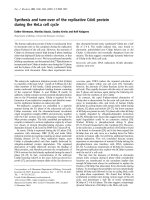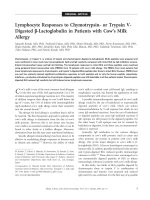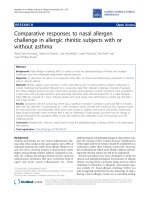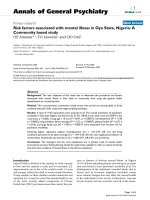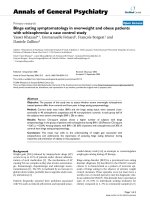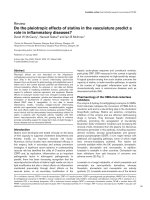Báo cáo y học: "Hormonal responses upon return of spontaneous circulation after cardiac arrest: a retrospective cohort study" potx
Bạn đang xem bản rút gọn của tài liệu. Xem và tải ngay bản đầy đủ của tài liệu tại đây (223.36 KB, 6 trang )
RESEARCH Open Access
Hormonal responses upon return of spontaneous
circulation after cardiac arrest: a retrospective
cohort study
Jin Joo Kim
1
, Sung Youl Hyun
2*
, Seong Youn Hwang
3
, Young Bo Jung
1
, Jong Hwan Shin
4
, Yong Su Lim
1
,
Jin Seong Cho
1
, Hyuk Jun Yang
1
, Gun Lee
1
Abstract
Introduction: Cardiac arrest is often fatal and can be extremely stressful to patients, even if spontaneous rhythm is
returned. The purpose of this study was to analyze the hormonal response after return of spontaneous circulation (ROSC).
Methods: This is a retrospective review of the chart and laboratory findings in a single medical facility. The
patients admitted to the intensive care unit after successful resuscitation after out-of-hospital cardiac arrest were
retrospectively identified and evaluated. Patients with hormonal diseases, patients who received cortisol treatment,
those experiencing trauma, and pregnant women were excluded. Serum cortisol, adrenocortico tropic hormone
(ACTH), and anti-diuretic hormone (ADH (vasopressin)) were analyzed and a corticotropin-stimulation test was
performed. Mortality at one week and one month after admission, and neurologic outcome (cerebral performance
category (CPC)) one month after admission were evaluated.
Results: A total of 117 patients, including 84 males (71.8%), were evaluated in this study. One week and one month
after admission, 87 (74.4%) and 65 patients (55.6%) survived, respectively. Relative adrenal insufficiency, and higher
plasma ACTH and ADH levels were associated with shock-related mortality (P = 0.046, 0.005, and 0.037, respectively),
and ACTH and ADH levels were also associated with late mortality (P = 0.002 and 0.004, respectively). Patients with
relative adrenal insufficiency, ACTH ≧5 pg/mL, and ADH ≧30 pg/mL, had a two-fold increased risk of a poor outcome
(shock-related mortality): (odds ratio (OR), 2.601 and 95% confidence interval (CI), 1.015 to 6.664; OR, 2.759 and 95% CI,
1.060 to 7.185; OR, 2.576 and 95% CI, 1.051 to 6.313, respectively). Thirty-five patients (29.9%) had a good CPC (1 to 2),
and 82 patients (70.1%) had a bad CPC (3 to 5). Age ≧50 years and an ADH ≧30 pg/mL were associated with a bad CPC
(OR, 4.564 and 95% CI, 1.794 to 11.612; OR, 6.568 and 95% CI, 1.918 to 22.483, respectively).
Conclusions: The patients with relative adrenal insufficiency and higher blood levels of ACTH and ADH upon
ROSC after cardiac arrest had a poor outcome. The effectiveness of administration of cortisol and ADH to patients
upon ROSC after cardiac arrest is uncertain and additional studies are needed.
Introduction
The recovery of spontaneous circulation (ROSC) after car-
diac arrest results in a whole body ischemia-reperfusion
syndrome called ‘post-cardiac arrest syndrome’ [1,2]. Post-
cardiac arrest syndrome is a unique pathophysiological pro-
cess that involves multiple organs incl uding post-cardiac
arrest brain injury, post-cardiac myocardial dysfunction,
systemic ischemia/reperfusion response and persistent pre-
cipitating pathophysiology [1]. Post-cardiac arrest syndrome
resembles multiorgan failure or septic shock but with a
more comprehen sive meaning. Immediately after ROSC,
the heart rate and blood pressure are very unstable. Most
patients need inotropics and vasopressors to manage hypo-
tension due to impaired vasoregulation, myocardial dys-
function, a nd volume depletion. Also, the possibility of
multi-organ failure and infection is increased because of
systemic inflammatory immune responses and activation of
the coagulation cascade [3,4]. In this study, several serum
* Correspondence:
2
Department of Cardiovascular Surgery, Gachon University Gil Hospital, 1198
Guwoldong Namdonggu Incheon, 405-760, South Korea
Full list of author information is available at the end of the article
Kim et al. Critical Care 2011, 15:R53
/>© 2011 Kim et al.; licensee BioMed Central Ltd. This is an open access article distributed und er th e terms of the Creative Commons
Attribution License ( which permits unrestricted use, distribution, and reproduction in
any medium, provided the original work is properly cited.
hormonal concentrations, including cortisol, adrenocortico-
tropic hormone (ACTH), and anti-diuretic hormone (ADH
(vasopressin)) were analyzed in relation to mortality and
neurologic outcome upon ROSC after cardiac arrest.
Materials and methods
Study population
The study institution is a 1,300-bed university hospital
with an annual emergency inte nsive care unit (EICU)
census of 1,000. This was a retrospective study of
patients with ROSC (>24 hours) after cardiac arrest who
were admitted to the EICU over a 34-month period
between March 2007 and December 2009. The basal
characteristics of the patients and the hormonal concen-
trations (cortisol, ACTH, and ADH) were obtained from
laboratory results in their medical records. The patients
with underlying hormonal disease (adrenal insuffic iency
and diabetes insipidus), patients who had already
received cortisol and ADH, patients who died within
24 hours of admission, patients who received trauma
and patients who were pregnant were excluded. This
study was approved by the institutional review board of
our center. Informed consent of blood sampling and
study was obtained from the next of kin of the patients
following the protocol used in our department.
Clinical evaluation and outcomes
The basal characteristics of patients and outcomes were
evaluated. Mortality and neurologic outcomes (Cerebral
Performance Category (CPC)) were evaluated. We
divided the patients into the following three groups: 1)
survivors and non-survivors one week after admission
(shock-related mortality); 2) survivors and non-survivors
one month after admission (late dead from neurological
dysfunction including brain death or cardiovascular pro-
blem including myocardial infarction and so on); and 3)
good CPC (1, 2) and poor CPC (3 to 5) one month after
admission.
Laboratory variables
The serum cortisol, ACTH, and ADH le vels were mea-
sured on the first morning after admission to the EICU
(between 12 and 24 hours after ROSC). Tetra cosactrin
(250 μg, Synacthene
®
, NORVATIS, Australia) was admi-
nist ered intravenously and blood samples were obtained
immediately before injection, and 30 and 60 minutes
after injec tion. The hormonal concentrations were mea-
sured by chemiluminescence immunoassay (CLIA).
Relative adrenal insufficiency was defined as an increase
in serum cortisol of ≤9 μg/dL.
Statistical analysis
The data were analyzed using SPSS software (version 16.0;
SPSS, Inc., Chicago, IL, USA). A t-test and chi-square test
were used and single and multiple variable logistic regres-
sion model analyses were performed to estimate the odds
ratios of dying, along with 95% confidence intervals (CIs).
Statistical significance was defined as a P-value < 0.05.
Results
The basal characteristics of the patients are shown in
Table 1. A total of 117 patients were evaluated in this
study; there were 84 males (71.8%). Forty-nine (41.9%)
patients had relative adrenal insufficiency on the first
morning after admission to the EICU. One week and
one month after admission, 87 (74.4%) and 65 patients
(55.6%) survived, respectively. Thirty-five patients
(29.9%) had a good CPC.
The hormonal concentrations by mortality and neuro-
logic outcomes are shown in Table 2. The basal cortisol
concentration was not significantly related to mortality
one week and one month after admission, or CPC score,
but the ACTH and ADH concentrations were signifi-
cantly related to mortality one week and one month
after admission, and the CPC score (Table 2).
Multiple logistic regression by mortality and CPC are
shown in Tables 3, 4 and 5. Relative adrenal insuffi-
ciency was significantly related to mortality one week
after admission by multiple logistic regression analysis
(odds ratio (OR), 2.601 and 95% confidence interval
(CI), 1.015 to 6.664), but not significantly related to
Table 1 Basal characteristics of the patients (N = 117,
median (IQR))
Gender, M, n (%) 84 (71.8)
Age (yr) 52(44 to 64)
BLS time (minutes) 5 (2 to 10)
Arrest time (minutes) 36 (21 to 51)
Epinephrine (mg) 3 (2 to 8)
HTN, yes, n (%) 33 (28.2)
DM, yes, n (%) 13 (11.1)
APACHE II 23 (20 to 27)
SOFA 10 (8 to 11)
Lactate (mmol/L) 8.7 (6.6 to 11.8)
Cortisol, basal (μg/dL) 24.91 (15.00 to 37.36)
Cortisol, 30 minutes (μg/dL) 28.73 (22.71 to 40.19)
Cortisol, 60 minutes (μg/dL) 29.56 (23.49 to 42.76)
RAI, Yes, n (%) 49 (41.9%)
ACTH (pg/mL) 5.40 (1.24 to 23.94)
ADH (pg/mL) 22.11 (12.42 to 35.19)
Survivors, at 1 wk 87 (74.4%)
Survivors, at 1 mo 65 (55.6%)
CPC, good, n (%) 35 (29.9%)
ACTH, adrenocorticotropic hormone; ADH, antidiuretic hormone, vasopressin;
APACHE, Acute Physiology and Chronic Health Evaluation; BLS, basic life
support; CPC, cerebral performance category (good CPC: 1 to 2, poor CPC: 3
to 5).
DM, diabetes mellitus; HTN, hypertension; SOFA, The Sequential Organ Failure
Assessment; RAI, relative adrenal insufficiency.
Kim et al. Critical Care 2011, 15:R53
/>Page 2 of 6
Table 2 Variables by RAI, mortality, and neurologic outcome (N = 117, median values)
RAI 1 wk mortality 1 mo mortality CPC
Yes No P-value Survived Dead P-value Survived Dead P-value Good Poor P-value
(n = 68) (n = 49) (n = 87) (n = 30) (n = 65) (n = 52) (n = 35) (n = 82)
Gender, M, n (%) 49 (72.1) 35 (71.4) 0.940 62 (71.3) 22 (73.3) 0.828 49 (75.4) 35 (67.3) 0.335 31 (88.6) 53 (64.6) 0.008*
Age (yr) 52 53 0.772 52 54 0.422 49 56 0.174 47 56 0.010*
BLS time (minutes) 6 4 0.076 5 6 0.093 5 6 0.207 4 6 0.200
Arrest time (minutes) 40 27 0.004* 31 50 <0.001* 25 44 <0.001* 25 38 0.010*
Epinephrine (mg) 5 2 <0.001* 3 7 0.001* 3 5 0.004* 3 4 0.338
HTN, yes, n (%) 18 (26.5) 15 30.6) 0.507 22 (25.3) 11 (36.7) 0.194 18 (27.7) 15 (28.8) 0.804 9 (25.7) 24 (29.3) 0.668
DM, yes, n (%) 6 (8.8) 7 (14.3) 0.283 8 (9.2) 5 (16.7) 0.298 5 (7.7) 8 (15.4) 0.152 1 (2.9) 12 (14.6) 0.102
APACHE II 23 22 0.889 22 27 0.001* 22 26 <0.001* 31 26 <0.001*
SOFA 10 9 0.062 9 12 <0.001* 9 11 0.001* 9 10 0.029*
Lactate (mmol/L) 9.40 7.55 0.013* 8.50 9.40 0.244 8.40 9.35 0.190 8.30 8.90 0.393
Cortisol, basal (μg/dL) 27.33 16.70 <0.001* 25.05 24.10 0.762 22.74 25.57 0.204 20.45 25.95 0.030*
Cortisol, 30 minutes (μg/dL) 28.74 28.54 0.543 28.89 27.35 0.380 28.29 29.54 0.584 26.45 29.32 0.273
Cortisol, 60 minutes (μg/dL) 29.12 32.46 0.100 29.67 24.64 0.154 29.20 30.74 0.946 29.02 31.53 0.572
ACTH (μg/dL) 7.85 2.12 0.006* 2.60 11.79 0.005* 2.35 9.41 0.002* 2.31 7.85 0.014*
ADH (pg/mL) 24.97 17.11 0.031* 19.81 28.65 0.037* 18.16 28.27 0.004* 14.42 24.80 0.001*
*P < 0.05.
ACTH, adrenocorticotropic hormone; ADH, antidiuretic hormone, vasopressin; APACHE, Acute Physiology and Chronic Health Evaluation; BLS, basic life support; CPC, cerebral performance category (good CPC: 1 to 2,
poor CPC: 3 to 5); DM, diabetes mellitus; HTN, hypertension; RAI, relative adrenal insufficiency; SOFA, The Sequential Organ Failure Assessment.
Kim et al. Critical Care 2011, 15:R53
/>Page 3 of 6
mortality one month after admission and CPC. ACTH
was related to mortality one wee k after admission, but
not to others. ADH was related to mortality one week
and one month after admission, and CPC based on mul-
tiple logistic regression analysis.
Discussion
Cardiac arrest is an extremely stressful condition, but
few studies have investigated the hormonal response
after a cardiac arrest. Post-cardiac arrest syndrome
shares many features with severe sepsis or shock,
including plasma cytokine elevation with deregulated
cytokine producti on, the presence of endotoxin in
plasma, coagul ation abnormalities, and adrenal dysfunc-
tion [1,5]. Post-cardiac arrest syndrome is a mixed con-
dition of systemic inflammatory response s, hypovolemia,
and myocardial dysfunction. During severe illness,
including cardiac arrest, many factors can impair the
normal hormonal response affecting the hypothalamic-
pituitary-adrenal axis [6].
ADH is essential for cardiovascular homeostasis and
release from the hypothalamus [7]. ADH synthesis is
primarily mediated by variations in plasma e ffective
osmolality and in blood v olume or pressure. Landry et
al. [8] reported that patients in septic shock indicated
inappropriately low plasma ADH levels and an increased
pressor sensitivity to exogenous ADH. Relative ADH
deficiency may contribute to vasodilatory shock in sep-
sis, likely because of impaired baroreflex-mediated hor-
mone secretion [9,10]. Sharshar et al. [11] determined
the serum ADH levels in patients with septic shock;
serial plas ma ADH levels were obtained at baseline, and
6, 24, 48, and 96 hours after the onset of shock. The
study showed that plasma ADH levels are increased in
nearly all cases during the initial phase of septic shock,
and decreased thereafter. A relative ADH deficiency is
more likely to occur 36 hours from the onset of shock
[11]. Thus, the time at which ADH is measured in rela-
tion to the onset of shock is important. In the current
study, the hormonal concentrations were m easured on
the first morning after ICU admission (12 to 24 hours
after ROSC). The optimal timing for obtaining the basal
and post-stimulation serum cortisol concentrations was
recommended at that time, and this was helpful in esti-
mating a prognosis of post-resuscitation disease [12].
Jochberger et al. [13] reported that serum ADH concen-
trations in patients after cardiac surgery (n = 96; 19.5 ±
30.4 pg/mL) were significantly higher than patients with
sepsis (n = 25; 6.5 ± 4.3 pg/mL), and patients admitted
for non-surgical diseases (n = 51; 6.5 ± 4.3 pg/mL; P <
0.001). Leclere et al. [14] reported that the median ADH
concentration in children with meningococcal septic
shock was 41.6 pg/mL and was higher in non-survivors,
but not significantly higher. In the current study, we
divided the patients into two groups based on the ADH
concentration. An ADH concentration >30 pg/mL was
associated with a two- to three-fold increased risk of
bad outcomes (early and late deaths or poor CPC) based
on multiple logistic regression analysis. The basal corti-
sol concentration was increased initi ally and not signifi-
cantly associated with mortality and CPC, but relative
adrenal insufficiency was related to early death (within
one week following admission). The patients with an
ACTH level >5 pg/mL had a three-fold increased risk of
early death. Based on the results of th e current study, we
suggest that within 24 hours of ROSC after cardiac arrest,
the cortisol, ACTH, and AD H levels are immediately
secreted from hypothalamic- pituita ry-adrena l activati on
following an extremely st ressful condit ion. An adequate
initial endogenous stress response may correlate with
recovery or even subsequent survival [13]. Hekimian
et al. [15] reporte d that patients who die of early re frac-
tory shock af ter cardiopulmonary resuscitation may have
an inadequate adrenal response to the stress. Relative
adrenal i nsufficiency was related to poor prognosis or
Table 5 Multiple logistic regression for bad CPC (at one
month after admission)
Factors P-
value
Odds
ratio
95% CI of
odds ratio
Observed
power
Lower Upper
Age ≧50 yr 0.001 4.564 1.794 11.612 0.914
ACTH ≧5 pg/mL 0.110 2.125 0.843 5.356 0.346
ADH ≧30 pg/mL 0.003 6.568 1.918 22.483 0.891
ACTH, adrenocorticotropic hormone; ADH, antidiuretic hormone; CPC, Cerebral
performance category.
Table 3 Multiple logistic regression for mortality (at one
week after admission)
Factors P-
value
Odds
ratio
95% CI of
odds ratio
Observed
power
Lower Upper
Age ≧50 yr 0.221 1.784 0.705 4.510 0.261
RAI (+) 0.046 2.601 1.015 6.664 0.371
ACTH ≧5 pg/mL 0.038 2.759 1.060 7.185 0.428
ADH ≧30 pg/mL 0.038 2.576 1.051 6.313 0.343
ACTH, adrenocorticotropic hormone; ADH, antidiuretic hormone; RAI, relative
adrenal insufficiency.
Table 4 Multiple logistic regression for mortality (at one
month after admission)
Factors P-
value
Odds
ratio
95% CI of
odds ratio
Observed
power
Lower Upper
Age ≧50 yr 0.008 3.217 1.348 7.680 0.770
ACTH ≧5 pg/mL 0.054 2.265 0.987 5.198 0.499
ADH ≧30 pg/mL 0.008 3.463 1.389 8.635 0.787
ACTH, adrenocorticotropic hormone; ADH, antidiuretic hormone.
Kim et al. Critical Care 2011, 15:R53
/>Page 4 of 6
increased mortality rate in patients with r esuscitation
after cardiac arrest [12,16]. The patients with relatively
rapid onset adrenal insufficiency, higher plasma ACTH
and ADH levels are related to death, and high concentra-
tions of ADH are also related to bad neurologic out-
comes. Because these patients have high concentrations
of hormones already, the replacement of hormones,
including cortisol and vasopressin, is uncertain. ADH did
not reduce the mortality rates as compared with other
drugs among patients with septic shock, a nd ADH did
not have a benefit over other drugs in increasing survi val
to discharge or improving neurologic outcomes in
patients after cardiac arrest [17,18].
Our study had the following limitations. First, this was
a retrospective, one-center study. Second, the sample
sizes were small. Third, hormonal responses are very
complicated. Variable factors could affect the hormonal
responses in our study.
Conclusions
The patients with relative adrenal insuffic iency and
higher blood levels of ACTH and ADH upon ROSC
after cardiac arrest had a poor outcome. The effective-
ness of administration of cortisol and ADH to patients
upon ROSC after cardiac arrest is uncertain ; additional
studies are needed.
Key messages
• The axis of the hypothalamic-pituitary-adrenal
gland was activated in patients with ROSC after car-
diac arrest.
• The patients with relative adrenal insufficiency, still
higher ACTH and ADH had a poor outcome.
Abbreviations
ACTH: adrenocorticotropic hormone; ADH: antidiuretic hormone, vasopressin;
APACHE: Acute Physiology and Chronic Health Evaluation; BLS: basic life
support; CLIA: chemiluminescence immunoassay; CPC: cerebral performance
category (good CPC: 1 to 2, poor CPC: 3 to 5); DM: diabetes mellitus; EICU:
emergency intensive care unit; HTN: hypertension; OR: odds ratio; RAI:
relative adrenal insufficiency; ROSC: return of spontaneous circulation; SOFA:
Sequential Organ Failure Assessment.
Author details
1
Department of Emergency Medicine, Gachon University Gil Hospital, 1198
Guwoldong Namdonggu Incheon, 405-760, South Korea.
2
Department of
Cardiovascular Surgery, Gachon University Gil Hospital, 1198 Guwoldong
Namdonggu Incheon, 405-760, South Korea.
3
Department of Emergency
Medicine, Sungkunkwan University School of Medicine, Samsung Changwon
Hospital, 50 Hapseongdong MansanHoiwongu, Changwon, 630-520, South
Korea.
4
Department of Emergency Medicine, Seoul Metropolitan
Government Seoul National University Boramae Medical Center, 40
Boramaegil, Dongjakgu, Seoul, 156-707, South Korea.
Authors’ contributions
All authors took part in the work and agree with the contents of the
manuscript. JJK, SYH, JHS and GL were involved in study conception and
design, JJK, HJY and YSL collected clinical data. YBJ, JSC and SYH performed
the data analysis. JJK and SYH drafted the manuscript. All authors read and
approved the final version of the manuscript.
Competing interests
The authors declare that they have no competing interests.
Received: 16 August 2010 Revised: 29 December 2010
Accepted: 7 February 2011 Published: 7 February 2011
References
1. Neumar RW, Nolan JP, Adrie C, Aibiki M, Berg RA, Böttiger BW, Callaway C,
Clark RS, Geocadin RG, Jauch EC, Kern KB, Laurent I, Longstreth WT Jr,
Merchant RM, Morley P, Morrison LJ, Nadkarni V, Peberdy MA, Rivers EP,
Rodriguez-Nunez A, Sellke FW, Spaulding C, Sunde K, Vanden Hoek T: Post-
cardiac arrest syndrome: Epidemiology, pathophysiology, treatment, and
prognostification. A consensus statement from the International Liaison
Committee on Resuscitation (American Heart Association, Australian and
New Zealand Council on Resuscitation, European Resuscitation Council,
Heart and Stroke Foundation of Canada, InterAmerican Heart
Foundation, Resuscitation Council of Asia, and the Resuscitation Council
of Southern Africa); the American Heart Association Emergency
Cardiovascualr Care Committee; the Council on Cardiovascular Surgery
and Anesthesia; the Council on cardiopulmonary Perioperative, and
Critical Care; the Council on Clinical Cardiology; and the Stroke Council.
Circulation 2008, 118:2452-2483.
2. Adrie C, Laurent I, Monchi M, Cariou A, Dhainaou JF, Spaulding C:
Postresuscitation disease after cardiac arrest: a sepsis-like syndrome?
Curr Opin Crit Care 2004, 10:208-212.
3. Adrie C, Adib-Conquy M, Laurent I, Monchi M, Vinsonneau C, Fitting C,
Fraisse F, Dinh-Xuan AT, Carli P, Spaulding C, Dhainaut JF, Cavaillon JM:
Successful cardiopulmonary resuscitation after cardiac arrest as a
“sepsis-like” syndrome. Circulation 2002, 106:562-568.
4. Adrie C, Monchi M, Laurent I, Um S, Yan SB, Thuong M, Cariou A,
Charpentier J, Dhainaut JF: Coagulopathy after successful
cardiopulmonary resuscitation following cardiac arrest: implication of
the protein C anticoagulant pathway. J Am Coll Cardiol 2005, 46:21-28.
5. Cooper MS, Stewart PM: Corticosteroid insufficiency in acutely ill patients.
N Engl J Med 2003, 348:727-734.
6. Schultz CH, Rivers EP, Feldkamp CS, Goad EG, Smithline HA, Martin GB,
Fath JJ, Wortsman J, Nowak RM: A characterization of hypothalamic-
pituitary-adrenal axis function during and after human cardiac arrest.
Crit Care Med 1993, 21:1339-1347.
7. Holmes CL, Patel BM, Russell JA, Walley KR: Physiology of vasopressin
relevant to management of septic shock. Chest 2001, 120:989-1002.
8. Landry DW, Levin HR, Gallant EM, Ashton RC, Seo S, D’Alessandro D, Oz MC,
Oliver JA: Vasopressin deficiency contributes to the vasodilation of septic
shock. Circulation 1997, 95 :1122-1125.
9. Landry DW, Oliver JA: The pathogenesis of vasodilatory shock. N Engl J
Med 2001, 345:588-595.
10. Jochberger S, Dörler J, Luckner G, Mayr VD, Wenzel V, Ulmer H,
Morgenthaler NG, Hasibeder WR, Dünser MW: The vasopressin and
copeptin response to infection, severe sepsis, and septic shock. Crit Care
Med 2009, 37:476-482.
11. Sharshar T, Blanchard A, Paillard M, Raphael JC, Gajdos P, Annane D:
Circulating vasopressin levels in septic shock. Crit Care Med 2003,
31:1752-1758.
12. Kim JJ, Lim YS, Shin JH, Yang HJ, Kim JK, Hyun SY, Rhoo I, Hwang SY,
Lee G: Relative adrenal insufficiency after cardiac arrest: impact on
postresuscitation disease outcome. Am J Emerg Med 2006, 24:684-688.
13. Jochberger S, Mayr VD, Luckner G, Wenzel V, Ulmer H, Schmid S, Knotzer H,
Pajk W, Hasibeder W, Friesenecker B, Mayr AJ, Dünser MW: Serum
vasopressin concentrations in critically ill patients. Crit Care Med 2006,
34:293-299.
14.
Leclere
F, Walter-Nicholet E, Leteurtre S, Noizet O, Sadik A, Cremer R,
Fourier C: Admission plasma vasopressin levels in children with
meningococcal septic shock. Intensive Care Med 2003, 29:1339-1344.
15. Hékimian G, Baugnon T, Thuong M, Monchi M, Dabbane H, Jaby D,
Rhaoui A, Laurent I, Moret G, Fraisse F, Adrie C: Cortisol levels and relative
adrenal insufficiency after successfully resuscitated cardiac arrest. Shock
2004, 22:116-119.
Kim et al. Critical Care 2011, 15:R53
/>Page 5 of 6
16. Pene F, Hyvernat H, Mallet V, Cariou A, Carli P, Spaulding C, Dugue MA,
Mira JP: Prognostic value of relative adrenal insufficiency after out-of-
hospital cardiac arrest. Intensive Care Med 2005, 31:627-33.
17. Russel JA, Walley KR, Singer J, Gorden AC, Hebert PC, Cooper DJ,
Holmes CL, Mehta S, Granton JT, Storms MM, Cook DJ, Presneill JJ, Ayers D,
VASST Investigators: Vasopressin versus norepinephrine infusion in
patients with septic shock. N Engl J Med 2008, 358:877-887.
18. Wyer PC, Perera P, Jin Z, Zhou Q, Cook DJ, Walter SD, Guyatt GH:
Vasopressin or epinephrine for out-of-hospital cardiac arrest. Ann Emerg
Med 2006, 48:86-97.
doi:10.1186/cc10019
Cite this article as: Kim et al.: Hormonal responses upon return of
spontaneous circulation after cardiac arrest: a retrospective cohort
study. Critical Care 2011 15:R53.
Submit your next manuscript to BioMed Central
and take full advantage of:
• Convenient online submission
• Thorough peer review
• No space constraints or color figure charges
• Immediate publication on acceptance
• Inclusion in PubMed, CAS, Scopus and Google Scholar
• Research which is freely available for redistribution
Submit your manuscript at
www.biomedcentral.com/submit
Kim et al. Critical Care 2011, 15:R53
/>Page 6 of 6
